Copy Works - Vincent van Gogh
Copies of the works of famous painters by Vincent van Gogh between 1887 and 1890 constitute an important place in his art.
Van Gogh was acquainted with Japanese wood prints in Antwerp, which would have a profound impact on his work. He had made color copies using picture tricks, such as highlighted strokes, flat areas of single colors and perspective effects. His Japanese wood prints were transformed into original paintings beyond imitation.
Inspired by Utagawa Hiroshige (1797-1858), the great master of Japanese art and contemporary, he produced many works. Unlike Hiroshige, he used the inverse of his gentle color application. The use of thick paints showed his authenticity. Moreover, he expanded the frame by playing with dimensions in the copy pictures and added the Japanese letters which he did not know. In short, Van Gogh Europeanized the material he had taken as a exemplar by fusing it with valid currents and passing it through his own strainer.
Van Gogh struggled to find a subject in the long winter months of Saint-Paul's asylum in which he stayed voluntary in 1889. He spent his time at the hospital making his own pictures and making copies.
Using the black-and-white lithography, reproductions and wooden prints of his brother Theo sent to him from Paris, transformed the paintings of painters such as Rembrandt van Rijn (1606-1669), Eugène Delacroix (1798-1863) and Jean-François Millet (1814-1875) into colorful paintings. The works of Millet, which Van Gogh was very impressed with, were important in these copies. The extraordinary simplicity of Millet's peasant figures influenced Van Gogh. Between the autumn of 1889 and the spring of 1890, he painted more than twenty pictures inspired by Millet.
These works were neither copies nor a version of the originals. It was an important part of the artist's own collection. Van Gogh's difficulty in finding a model and staying closed in the clinic caused him to tendency to this area.
Van Gogh explains the purpose of the copies in his letters to his brother Theo:
“I can assure you that it interests me enormously to make copies, and that not having any models for the moment it will ensure, however, that I don’t lose sight of the figure.”
“I would like to have all of this, at least the etchings and the wood engravings. It’s a study I need, for I want to learn. Although copying may be the old system, that absolutely doesn’t bother me at all.”
“I place the black-and-white by Delacroix or Millet or after them in front of me as a subject. And then I improvise colour on it but, being me, not completely of course, but seeking memories of their paintings – but the memory, the vague consonance of colours that are in the same sentiment, if not right – that’s my own interpretation.
Heaps of people don’t copy. Heaps of others do copy – for me, I set myself to it by chance, and I find that it teaches and above all sometimes consoles.
So then my brush goes between my fingers as if it were a bow on the violin and absolutely for my pleasure.”
To Theo van Gogh. Saint-Rémy-de-Provence, on or about Friday, 20 September 1889.
Van Gogh's examples of copies of Eugène Delacroix, Jean-François Millet, Rembrandt van Rijn, Honoré Daumier, Gustave Doré, Émile Bernard, Virginie Demont Breton, Jacob Jordaens, Utagawa Hiroshige and Keisai Eisen and his comments in his letters on these works were presented.
Copies of Jean-François Millet
In his letter to Willemien van Gogh, Anthan van Rappard, Emile Bernard and Theo about the copies of Jean-François, Van Gogh says:
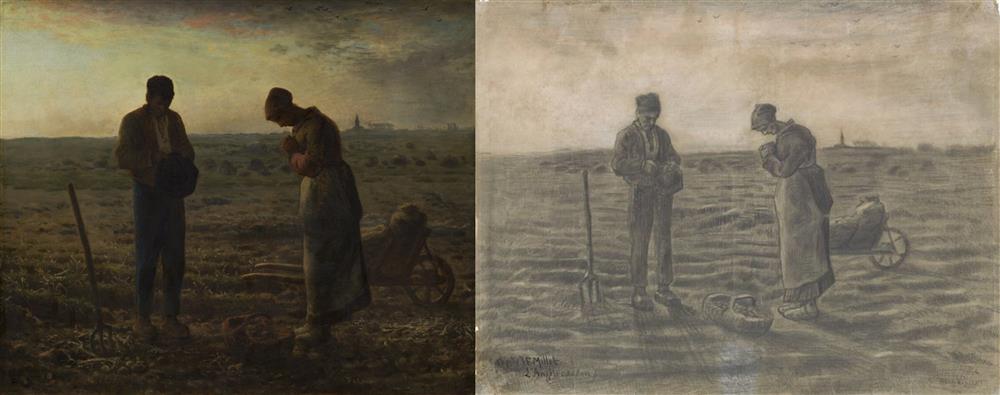
The Angelus; Millet, 1857/1859 - Van Gogh, 1880
“I saw these paintings at Durand-Ruel’s. There they have no fewer than 25 etchings after Millet, and the same number after Michel, and masses after Dupré and Corot and all other artists, to be had for 1 franc apiece. That’s tempting indeed. I couldn’t resist buying a couple after Millet: I bought the last 3 of The evening angelus, and my brother will of course receive one when the opportunity arises.”
To Theo van Gogh. Paris, Tuesday, 28 March 1876.
“But equally sublime to my mind is — Millet’s Angelus, that same dusk, that same infinite emotion — or that solitary figure by Breton in the Luxembourg or his Spring.”
To Theo van Gogh. Nuenen, Thursday, 2 October 1884.
“So although yesterday more than half a million francs were paid for Millet’s Angelus, don’t go believing that more souls will feel what was in Millet’s soul. Or that middle-class people or workers will begin to put in their houses the lithograph of that Millet Angelus, for example. Don’t go believing that the painters who are still working in Brittany among the peasants will have more encouragement for that matter, less of the same black famine that always surrounded Millet, above all more courage.”
To Willemien van Gogh. Saint-Rémy-de-Provence, Tuesday, 2 July 1889.
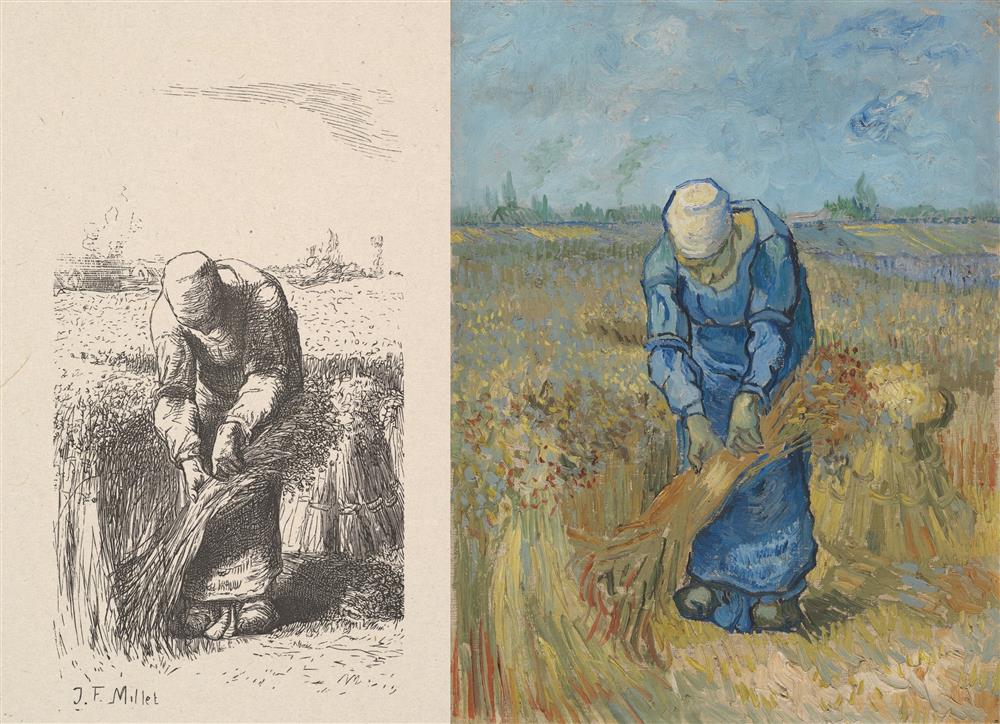
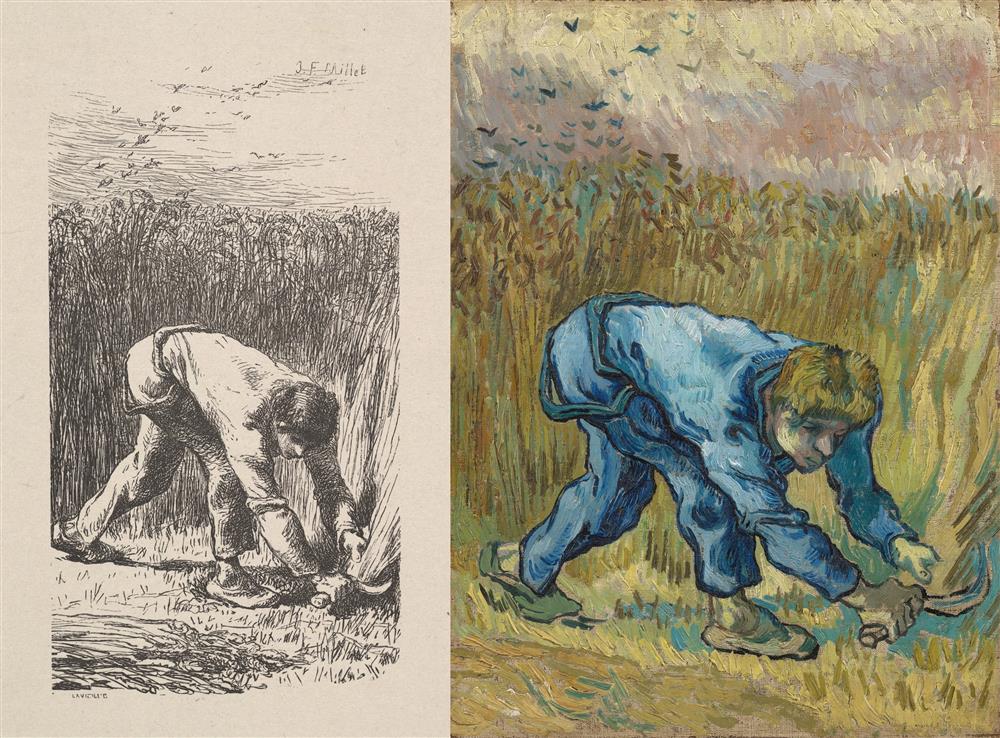
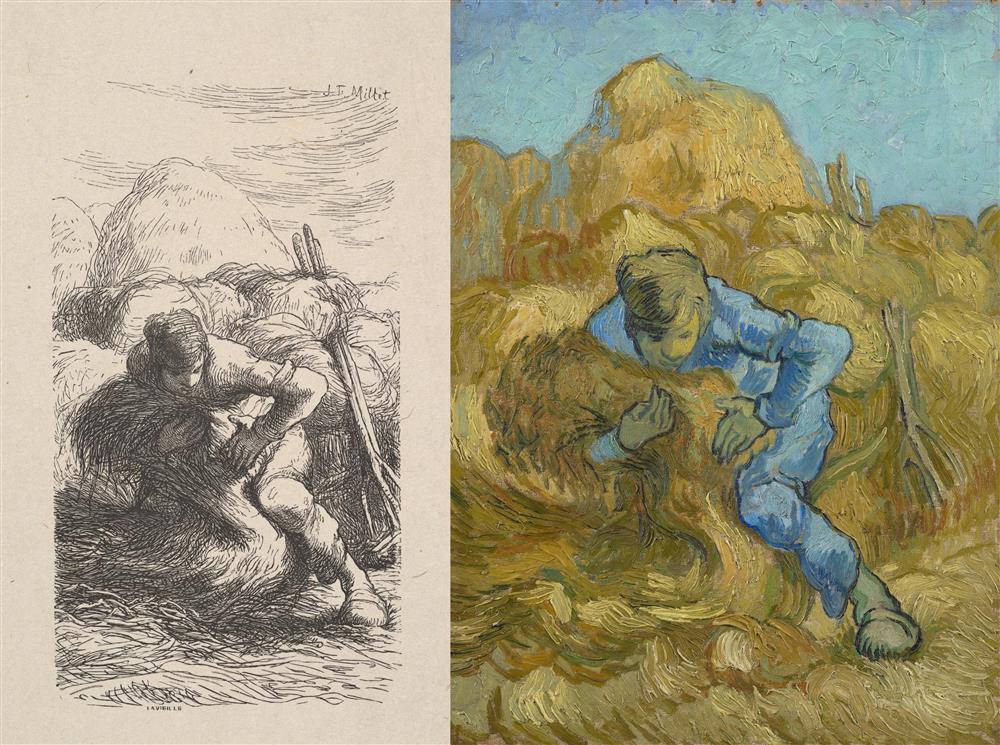
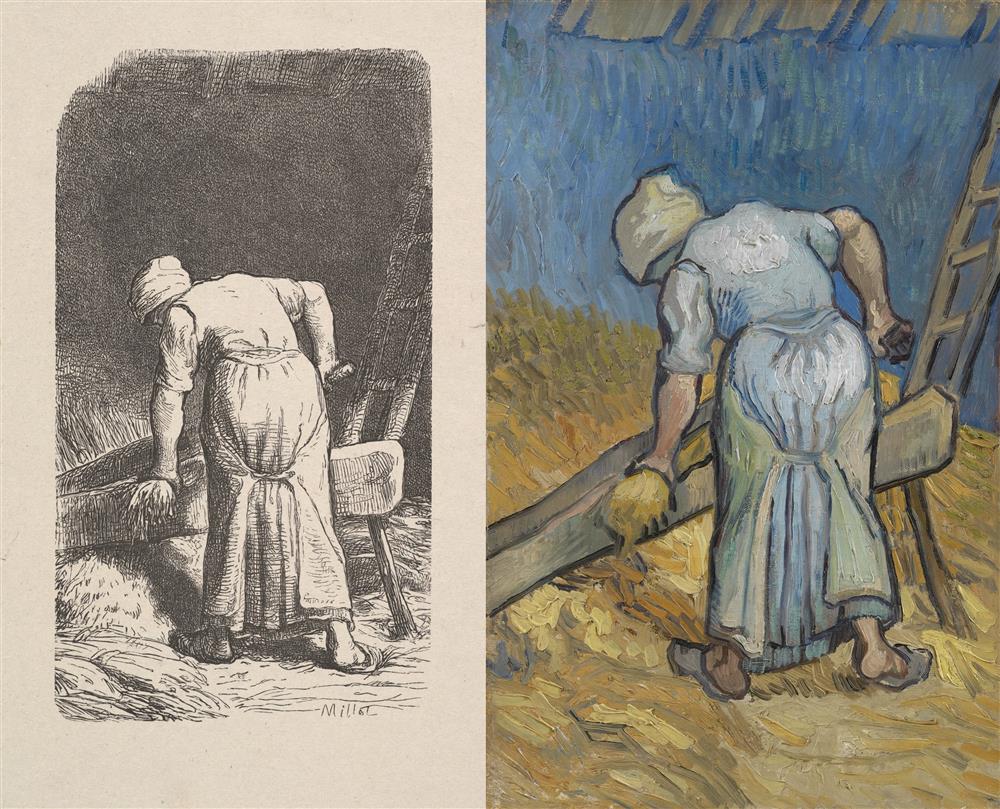
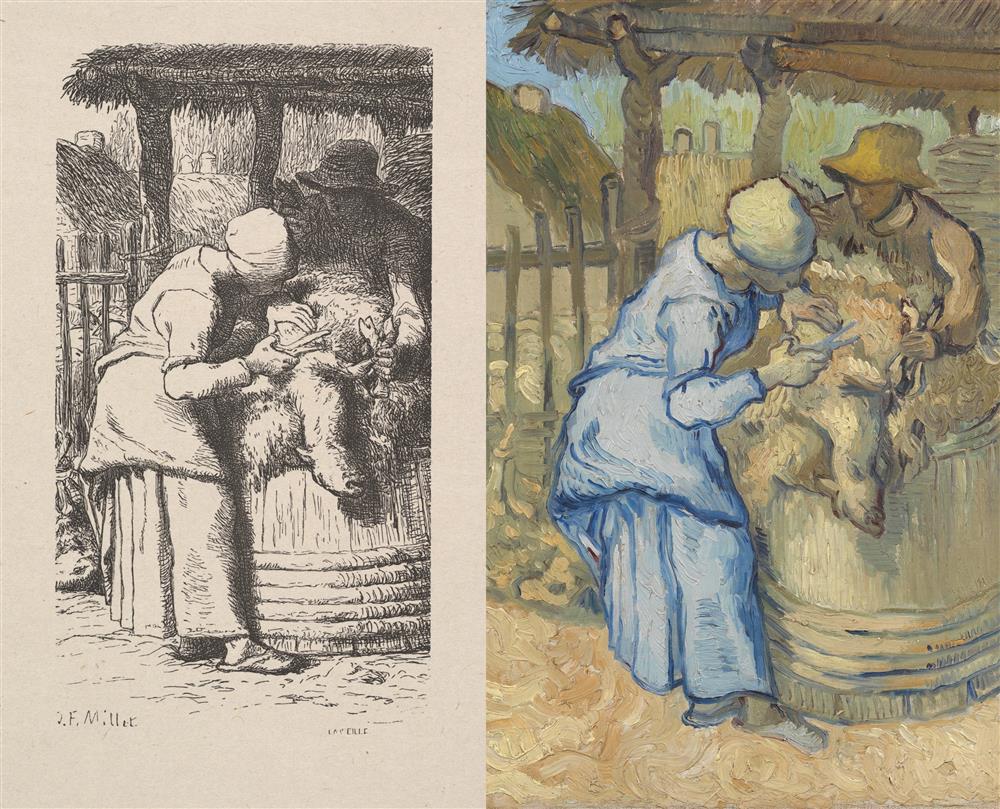
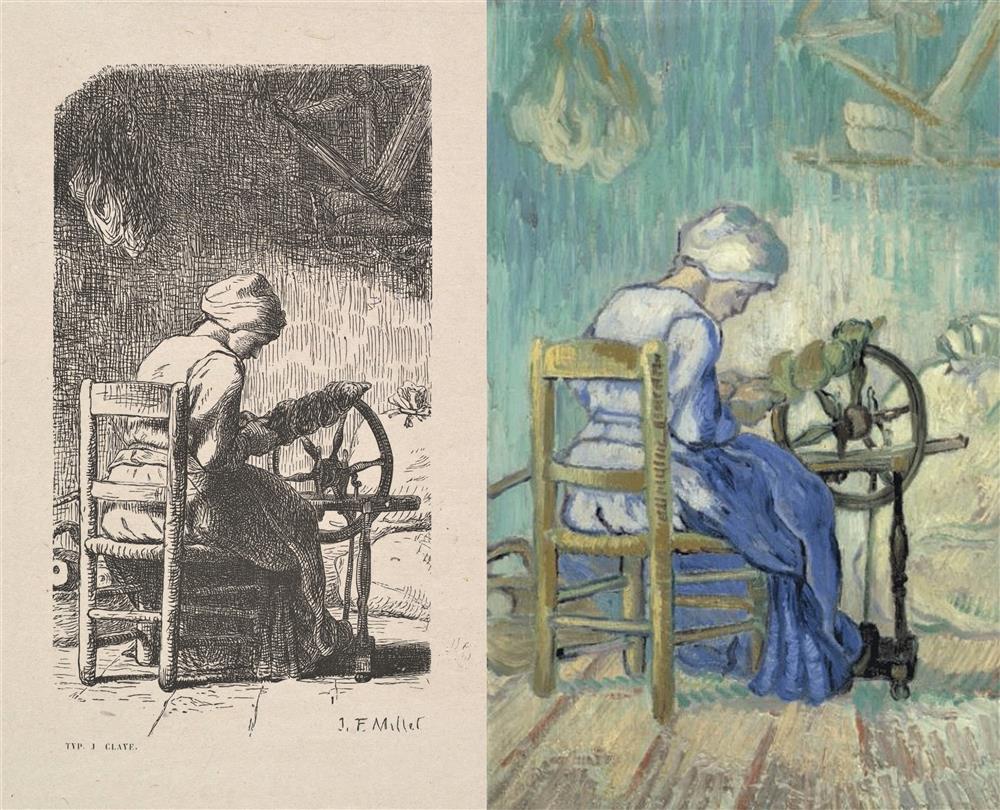
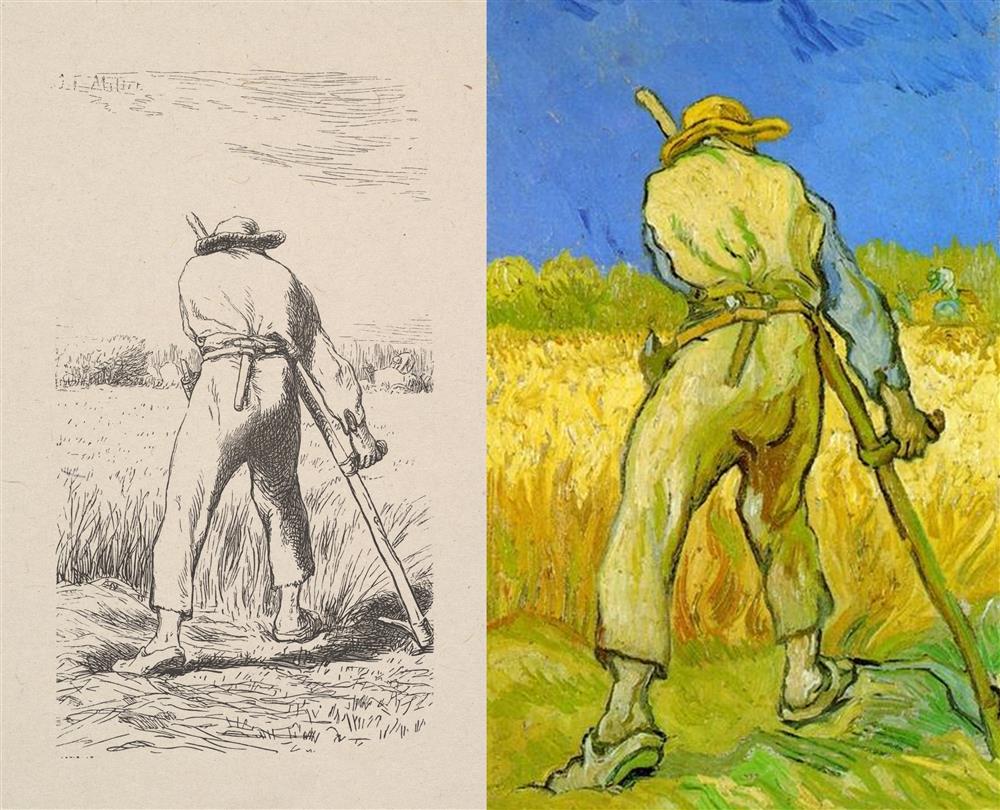
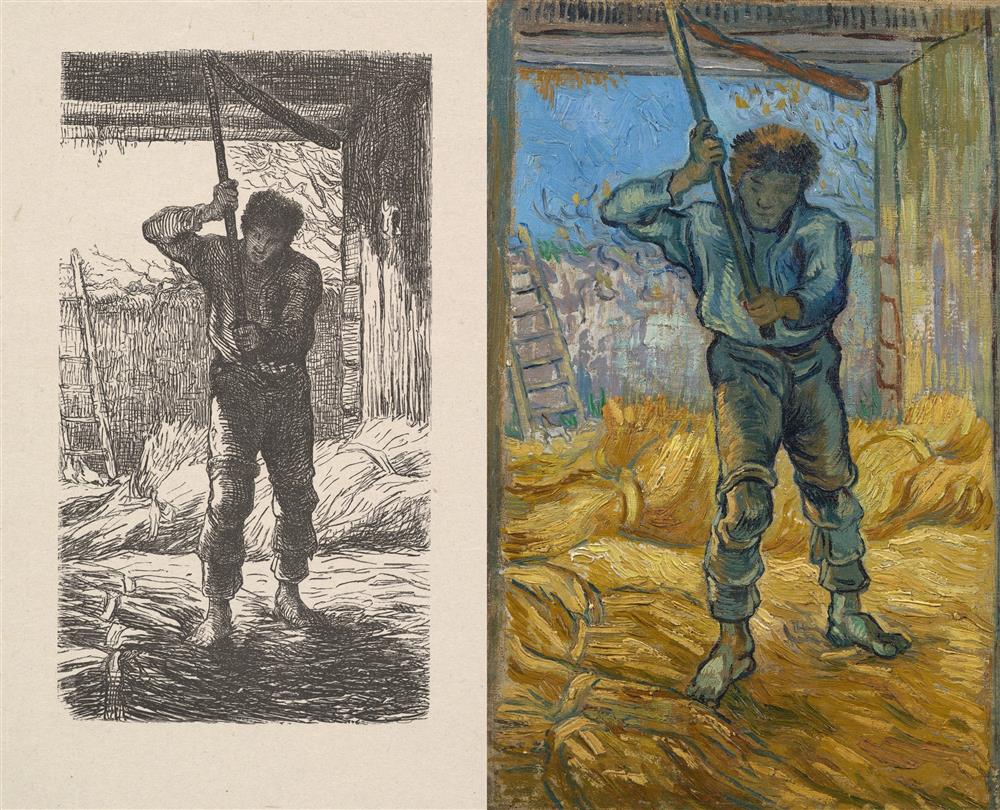
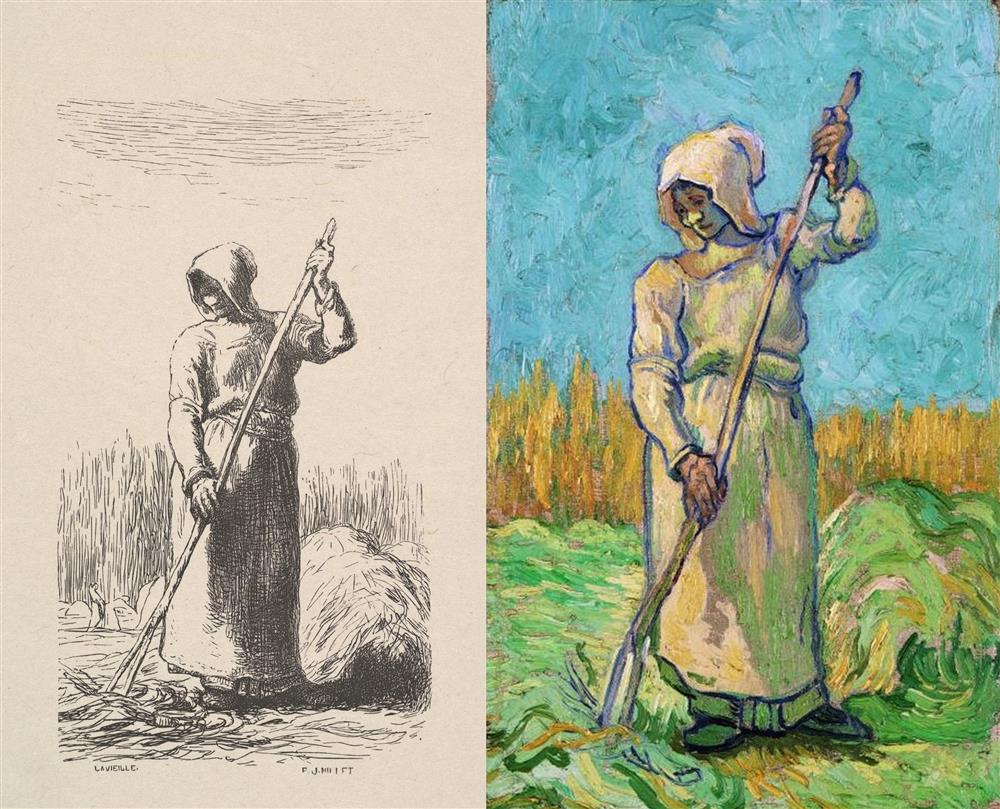
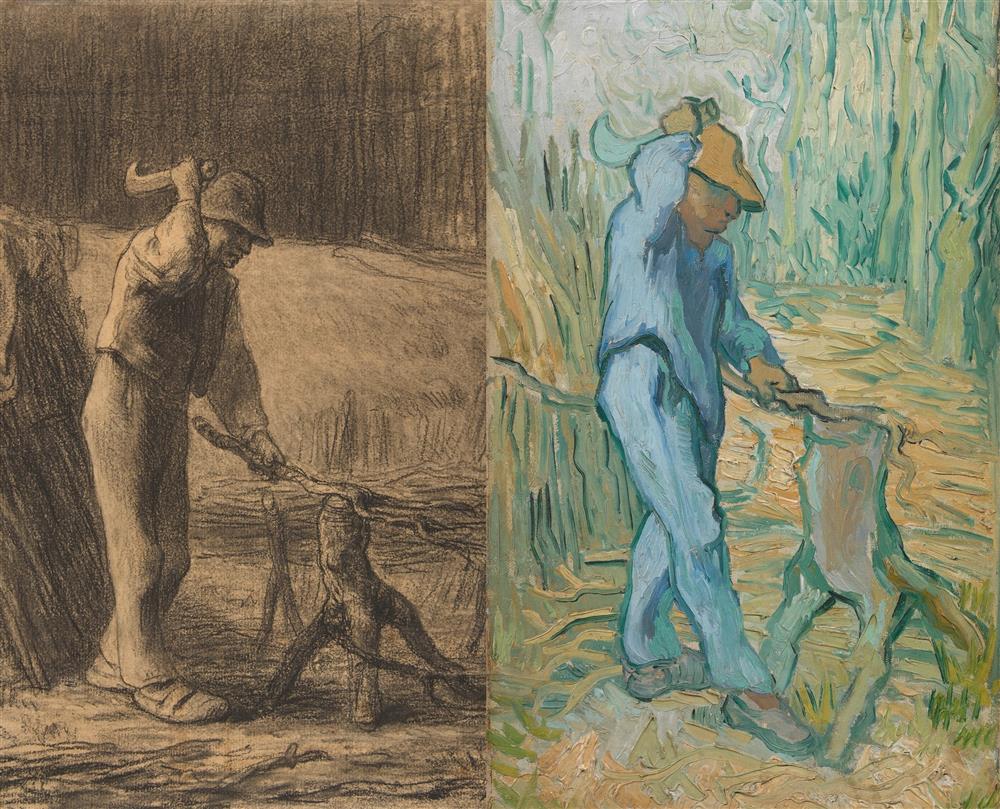
The Labours of The Fields; Millet, 1853 - Van Gogh, 1889
“I’ve collected a lot of woodcuts this winter. Your Millets have been augmented with various others, and you’ll see that your wealth of woodcuts &c. haven’t had an unproductive stay with me. I now have 24 woodcuts by or after Millet, counting the Labours of the fields. But my own drawing is the main thing, and everything has to work towards that.”
To Theo van Gogh. Brussels, Saturday, 2 April 1881.
“At present I have 7 copies out of ten of Millet’s Travaux des champs.
I can assure you that it interests me enormously to make copies, and that not having any models for the moment it will ensure, however, that I don’t lose sight of the figure.
What’s more, it will give me a studio decoration for myself or another.
I would like also to copy the Sower and the Diggers.
There’s a photo of the Diggers after the drawing.
And Lerat’s etching of the Sower at Durand-Ruel’s.
In these same etchings is the Field under the snow with a harrow. Then The four times of the day, there are examples of them in the collection of wood engravings.
I would like to have all of this, at least the etchings and the wood engravings.”
“You’ll be surprised what effect the Travaux des champs take on in colour, it’s a very intimate series of his.”
“Today I attempted the Sheep shearer in a colour scale ranging from lilac to yellow. They are small canvases, around no. 5.”
“When you say in your letter that I’ve never done anything but work, no – that’s not right – I myself am very, very discontented with my work, and the only thing that consoles me is that experienced people say that one must paint for 10 years for nothing. But what I’ve done is only those 10 years of unfortunate studies that didn’t come off. Now a better period could come, but I’ll have to strengthen the figure work, and I must refresh my memory by very close study of Delacroix, Millet. Then I’ll try to sort out my drawing. Yes, every cloud has a silver lining, it gives one more time for study.”
“I’d very much like to see Millet reproductions in schools, I think there would be children who became painters if only they saw good things.”
To Theo van Gogh. Saint-Rémy-de-Provence, on or about Friday, 20 September 1889.
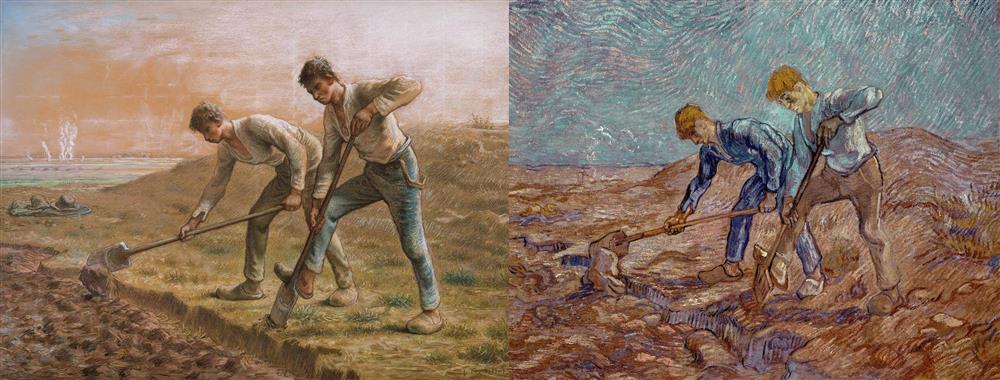
Two Peasant Digging; Millet, 1866 - Van Gogh, 1899
“Drew The diggers by Millet after a photo by Braun that I found at Schmidt’s and which he lent me with that of The evening angelus. I sent both those drawings to Pa so that he could see that I’m doing something.”
To Theo van Gogh. Brussels, Monday, 1 November 1880.
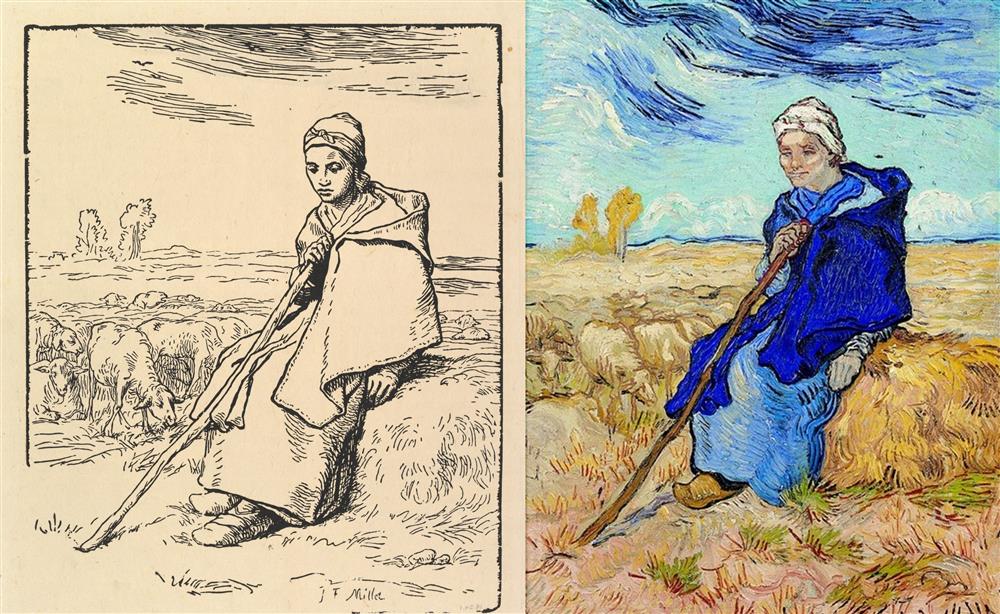
The Shepherdess; Millet, 1830/1875 - Van Gogh, 1889
“Take the etching by Millet, The diggers, take an engraving by Albrecht Dürer, take above all the large woodcut by Millet himself, The shepherdess, and then one sees fully what can be expressed by such an outline.
And as you say, one then has the feeling ‘that’s how I’d always have wanted to do it if I’d always gone my own way’ &c. That’s well said, old chap, and spoken like a man.”
To Anthon van Rappard. The Hague, on or about Friday, 15 June 1883.
“Another, even more telling example is the large Shepherdess woodcut by Millet which you showed me last year, and which has remained in my memory. Also, for example, the pen sketches by Ostade and Peasant Bruegel.”
To Theo van Gogh. The Hague, Monday, 31 July 1882.
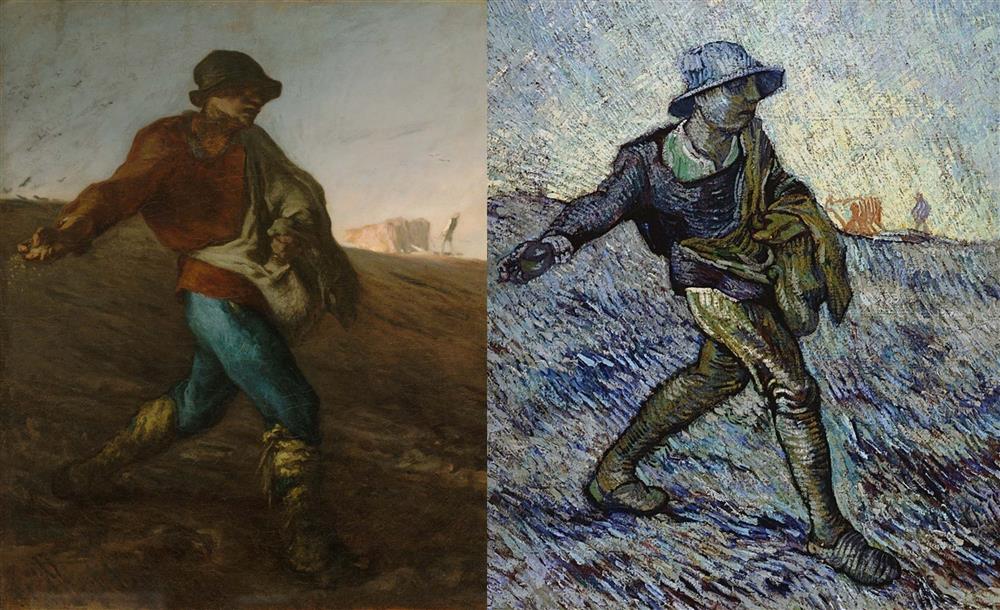
The Sower; Millet, 1850 - Van Gogh, 1890
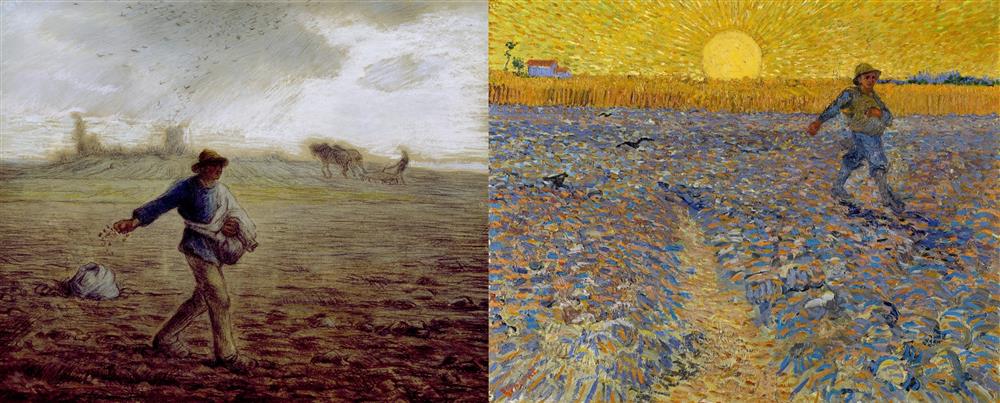
The Sower; Millet, 1865 - Van Gogh, 1888
“Here’s croquis of a sower.
Large field with clods of ploughed earth, mostly downright violet.
Field of ripe wheat in a yellow ochre tone with a little crimson.
The chrome yellow 1 sky almost as bright as the sun itself, which is chrome yellow 1 with a little white, while the rest of the sky is chrome yellow 1 and 2 mixed, very yellow, then.
The sower’s smock is blue, and his trousers white. Square no. 25 canvas. There are many repetitions of yellow in the earth, neutral tones, resulting from the mixing of violet with yellow, but I could hardly give a damn about the veracity of the colour. Better to make naive almanac pictures — old country almanacs, where hail, snow, rain, fine weather are represented in an utterly primitive way. The way Anquetin got his Harvest so well.
I don’t hide from you that I don’t detest the countryside — having been brought up there, snatches of memories from past times, yearnings for that infinite of which the Sower, the sheaf, are the symbols, still enchant me as before.”
To Emile Bernard. Arles, on or about Tuesday, 19 June 1888.
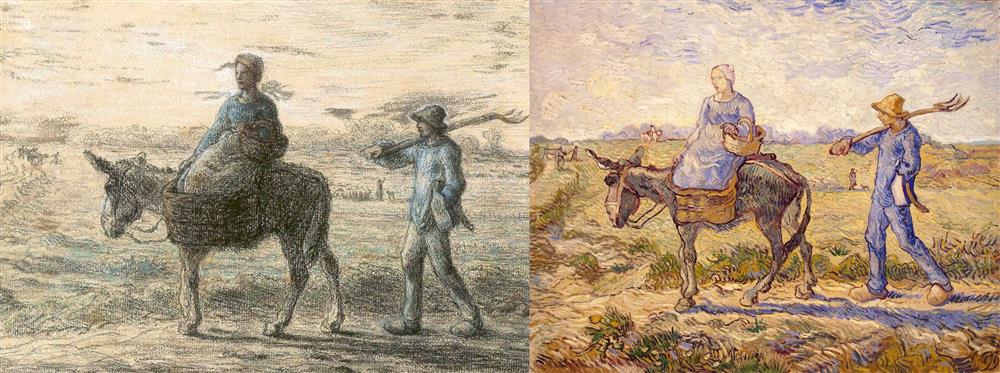
Morning. Going to Work; Millet, 1857/1858 - Van Gogh, 1890
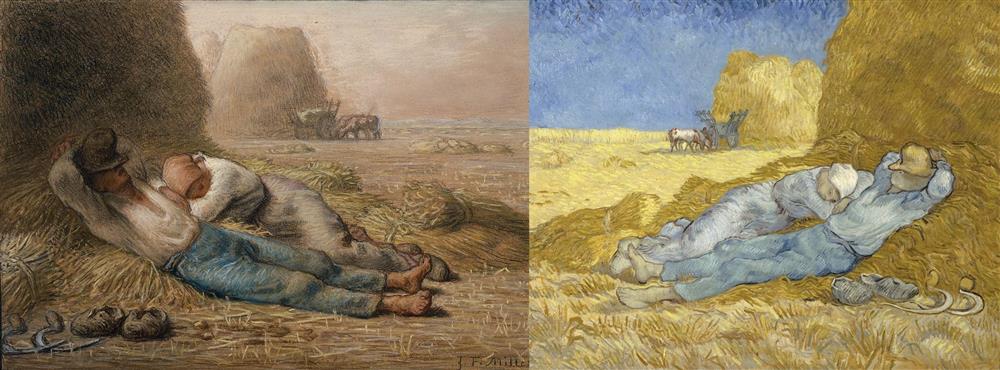
The Siesta; Millet, 1866 - Van Gogh, 1890
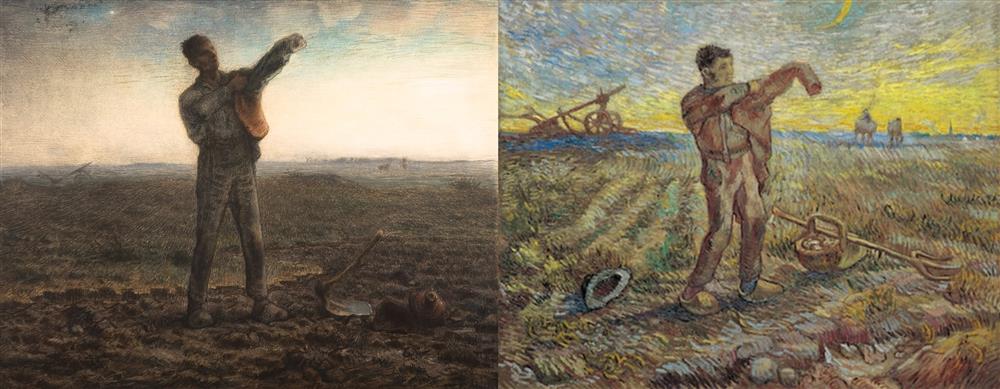
End of the Day; Millet, 1865/1870 - Van Gogh, 1890
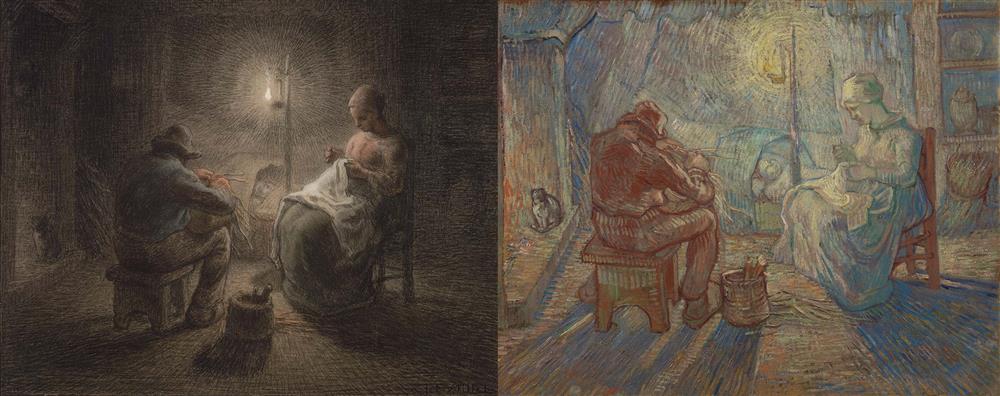
Evening; Millet, 1867 - Van Gogh, 1889
“My dear Theo,
Enclosed I’m sending you a list of colours I need as soon as possible.
You gave me very great pleasure by sending me those Millets, I’m working on them zealously. I was growing flabby by dint of never seeing anything artistic, and this revives me. I’ve finished The evening and am working on The diggers and the man who’s putting his jacket on, no. 30 canvases, and The sower, smaller. The evening is in a range of violets and soft lilacs, with light from the lamp pale citron, then the orange glow of the fire and the man in red ochre. You will see it. It seems to me that doing painting after these Millet drawings is much rather to translate them into another language than to copy them. Apart from that I have a rain effect on the go, and an evening effect with tall pines.”
To Theo van Gogh. Saint-Rémy-de-Provence, on or about Sunday, 3 November 1889.
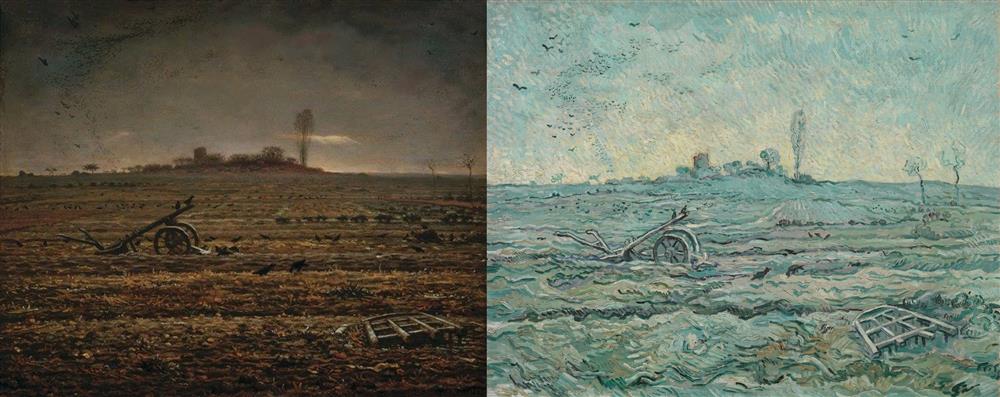
Snow-Covered Field with a Harrow; Millet, 1862 - Van Gogh, 1890
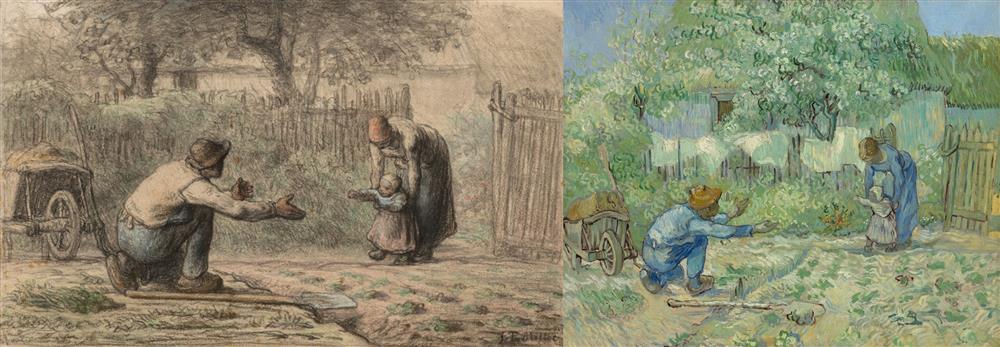
First Steps; Millet, 1858/1866 - Van Gogh, 1890
“My dear Theo,
Thanks for your last letter, I hope that Wil has recovered from her indisposition and that it was no more serious than you say. Thanks very much, too, for the consignment of canvases and colours, which has just arrived. I have enough subjects for paintings in my head for when the weather permits me to work outside.
What you say about the copy after Millet, The evening, pleases me. The more I think about it the more I find that there’s justification for trying to reproduce things by Millet that he didn’t have the time to paint in oils. So working either on his drawings or the wood engravings, it’s not copying pure and simple that one would be doing. It is rather translating into another language, the one of colours, the impressions of chiaroscuro and white and black. In this way I’ve just finished the three other ‘times of the day’ after the wood engravings by Lavieille. It took me a lot of time and a lot of trouble. For you know that this summer I’ve already done The labours of the fields. Now these reproductions – you’ll see them one day – I haven’t sent, because more than the former ones they were gropings, but they have, however, served me well for The times of the day. Later, who knows, perhaps I could do lithographs of them. I’m curious as to what Mr Lauzet will say about them. They’ll take a good month more to dry, the last three, but once you have them you’ll clearly see that they were done through a most profound and sincere admiration for Millet. Then, even if they’re criticized one day or despised as copies, it will remain no less true that it’s justifiable to try to make Millet’s work more accessible to the ordinary general public.”
“This week I’m going to start on Millet’s ‘Snow-covered field’ and ‘First steps’ in the same format as the others. Then there’ll be 6 canvases forming a series, and I assure you that I’ve worked on them, these last three of the ‘Times of the day’, with much thought to calculate the colour.”
“So what I’m pondering doing in painting is Daumier’s Drinkers and Régamey’s Penitentiary. You’ll find them in among the wood engravings. I’m busy with the Millets for the moment, but this is to say that I’ll find no lack of things to work on. Thus even half locked up I’ll be able to occupy myself for a long time.”
To Theo van Gogh. Saint-Rémy-de-Provence, on or about Monday, 13 January 1890.
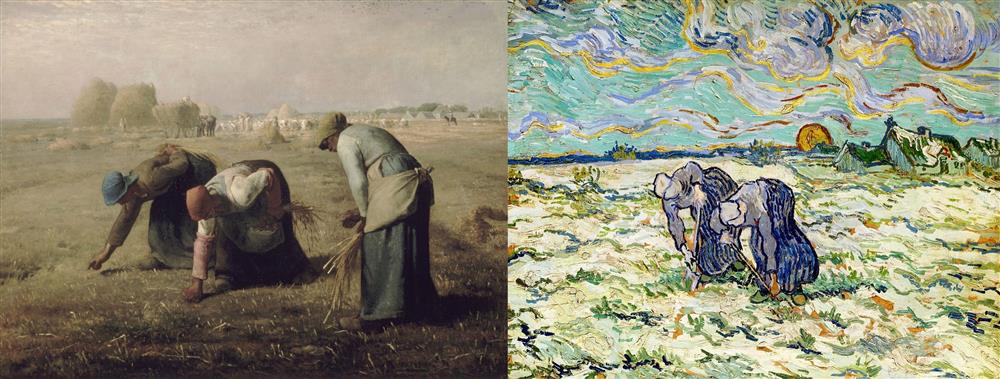
The Gleaners; Millet, 1857 - Van Gogh, 1890
“My dear Theo, I haven’t been able to write to you until now, but as I’m feeling a little better these days I didn’t want to delay wishing a happy year to you, your wife and your child, since it’s your birthday. At the same time, please accept the various paintings I’m sending you with my thanks for all the kindnesses you’ve shown me, for without you I would be most unhappy.
You’ll see that first there are canvases after Millet. As these aren’t destined for public viewing, perhaps you’ll make a present of them to our sisters sooner or later. But first you must keep the ones you consider good, and as many as you wish, they’re absolutely yours. One of these days you must send me some other things by ancient and modern artists to do, if you find any.”
To Theo van Gogh. Saint-Rémy-de-Provence, Tuesday, 29 April 1890.
“One must – it is true – believe in it a little from time to time in order to see it. If, for myself, I wanted to continue, let’s call it translating certain pages of Millet, then in order to prevent people, not criticizing me, I couldn’t care about that, but bothering or obstructing me under the pretext that I’m manufacturing copies – then among the artists I need people like Russell or Gauguin to carry this task to a successful conclusion, to make something serious of it. To do the things by Millet that you sent, for example, the choice of which I consider completely right – I have scruples of conscience, and I took the pile of photographs and I sent them unhesitatingly to Russell so that I shouldn’t see them again until I’d thought long and hard about it. I don’t want to do it before first having heard something of your opinion, then also that of certain others on those that you’ll soon receive. Without that I’d have scruples of conscience, a fear that it might be plagiarism. And not now, but in a few months, I’ll try to get Russell’s honest opinion about the usefulness of the thing. In any case, Russell has outbursts, he gets angry, he says something true, and that’s what I need sometimes. You know that I found the Virgin so dazzling that I didn’t dare look. Immediately I felt a – ‘not yet’. Now the illness makes me very sensitive, and for the moment I don’t feel capable of continuing these ‘translations’ when it would involve such masterpieces. I’m stopping with the sower, which is in progress and isn’t coming along as would be desirable. However, being ill, I thought a lot about continuing this work, and that when I do it I do it calmly, you’ll see it soon when I send the five or 6 finished canvases.”
To Theo van Gogh. Saint-Rémy-de-Provence, Saturday, 1 February 1890.












